Lord Krishna famous temples in India
Namaste friends, how are you doing today? Welcome to #BhagavanBhakthi website / blog.
Bhagavan Lord Sri Krishna blessings to you and your family!
In this website / blog, you will always learn about #Hinduism #Sanskrit language.
Also subscribe to my YouTube channel from this link #BhagavanBhakthi to view videos about #Hinduism #Sanskrit language.
Just before moving towards to know about “Lord Krishna famous temples in India“, let us know few basic information about Lord Krishna.
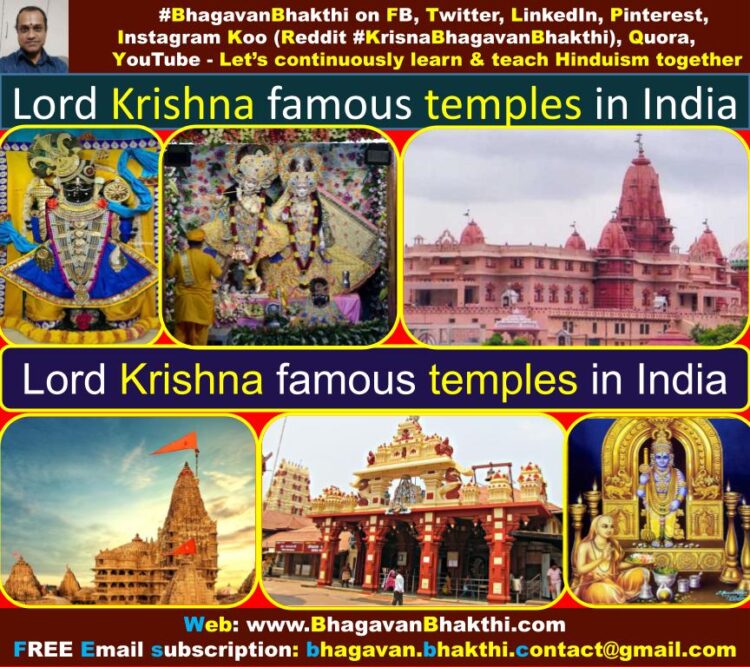
Lord Krishna is an avatar of Lord Vishnu and among the dasha avatar (10 avatars) Lord Krishna’s avatar is the 8th avatar.
Lord Krishna mother name is Devaki Devi and father name is Vasudeva.
Lord Krishna foster mother name is Yashoda Devi and foster father name is Nanda Maharaja (Nanda Gopa Maharaja).
Now, let us know the “Lord Krishna famous temples in India“.
First let us know the list of the names of the Lord Krishna famous temples in India and later let us have a brief information about those temples.
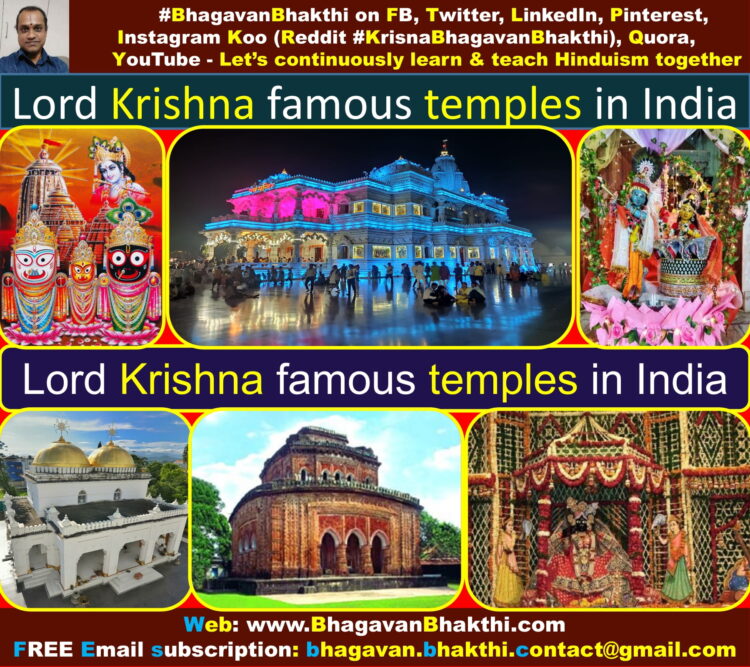
List of the Lord Krishna famous temples in India are as given below:
Dwarkadhish temple, Mathura
Krishna Janmasthan Temple Complex, Mathura
Dwarkadhish Temple, Dwaraka
Sri Vitthal Rukmini Temple, Pandharpur
Udupi Sri Krishna Matha, Udupi
Jagannath Temple, Puri
Prem Mandir, Vrindavan
Shree Govindajee Temple, Imphal
Kantajew Temple, Bangladesh
Bankey Bihari Temple, Vrindavan
Radha Madhab Temple, Bishnupur
Radha Raman Temple, Vrindavan
Shrinathji Temple, Nathdwara, Rajasthan
Madan Mohan Temple, Karauli, Rajasthan
Guruvayur Temple, Kerala
Radha Vallabh Temple, Vrindavan
Radha Madan Mohan Temple, Vrindavan
Radha Damodar Temple, Junagadh
Radha Damodar Temple, Vrindavan
Govind Dev Ji Temple, Jaipur
Brief information about Lord Krishna famous temples in India is as given below:
Dwarkadhish temple, Mathura : Sri Dwarkadhish is another name of Lord Krishna.
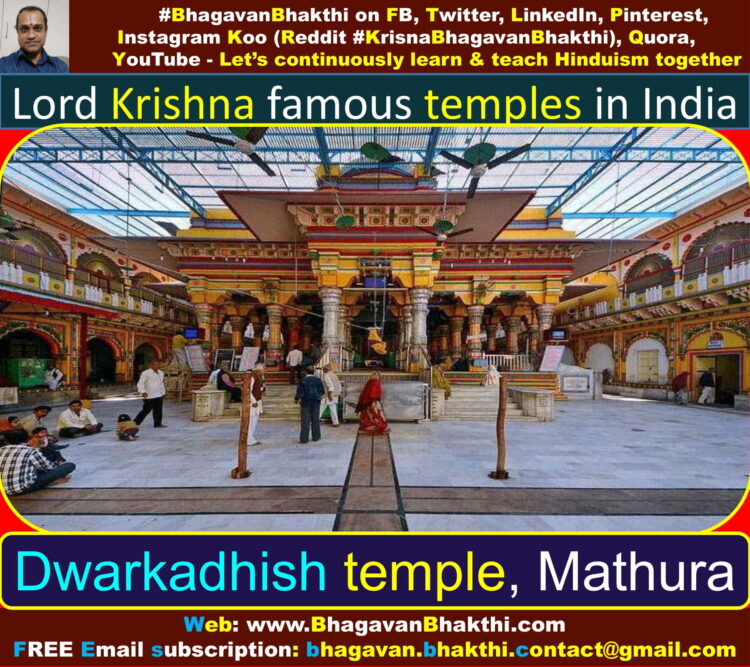
Lord Sri Dwarkadhish Mandir is one of the historic temples in the Mathura city, in Uttar Pradesh state of India.
The present structure of the temple was constructed up by Seth Gokul Das Parikh.
Seth Gokul Das Parikh was the treasurer of then Gwalior State (Scindia) in 1814, with consent and donation from Shrimant Daulatrao Scindia, Maharajah of Gwalior.
In this renowned temple, Lord Krishna is worshipped in his Dwarkanath or Dwarkadhish form along with his counterpart Goddess Sri Radha Devi in form of Sri Radharani.
Another small temple of another form of Lord Krishna (Lord Vishnu) Shaligram is also built-up within the same temple courtyard.

Krishna Janmasthan Temple, Mathura : The Krishna Janmasthan Temple complex is a group of Hindu temples in Mallapura, in Mathura district of Uttar Pradesh.
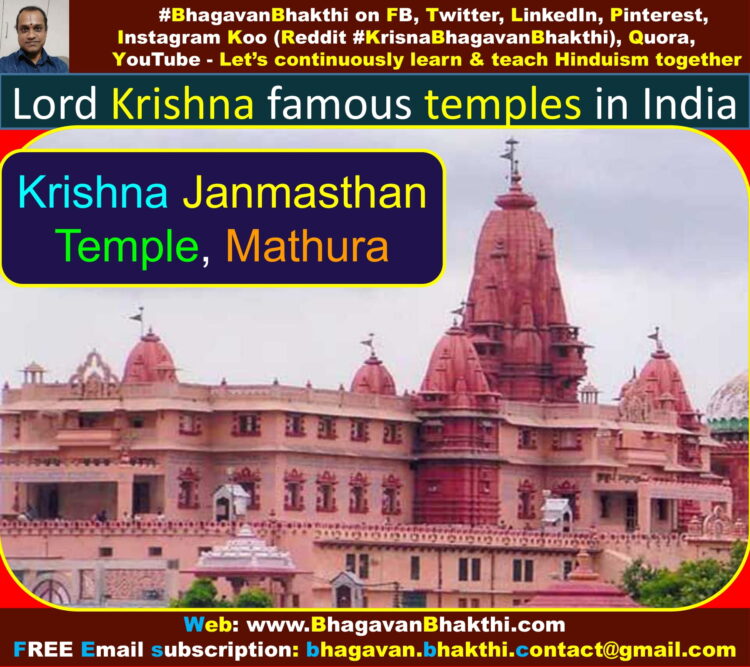
These different temples are built at the location where the Lord Krishna was born.
According to Mahabharat and Srimad Bhagavatam, Lord Krishna was born to Devaki and Vasudeva.
Lord Krishna was born in a prison cell where they were confined by his maternal uncle Kansa (Kamsa), a king of Mathura, due to prophecy of his (Kansa / Kamsa) death by the child of Devaki.
Lord Krishna’s great grandson Vajranabha (Vajranabh) constructed the original temple of Lord Krishna here.
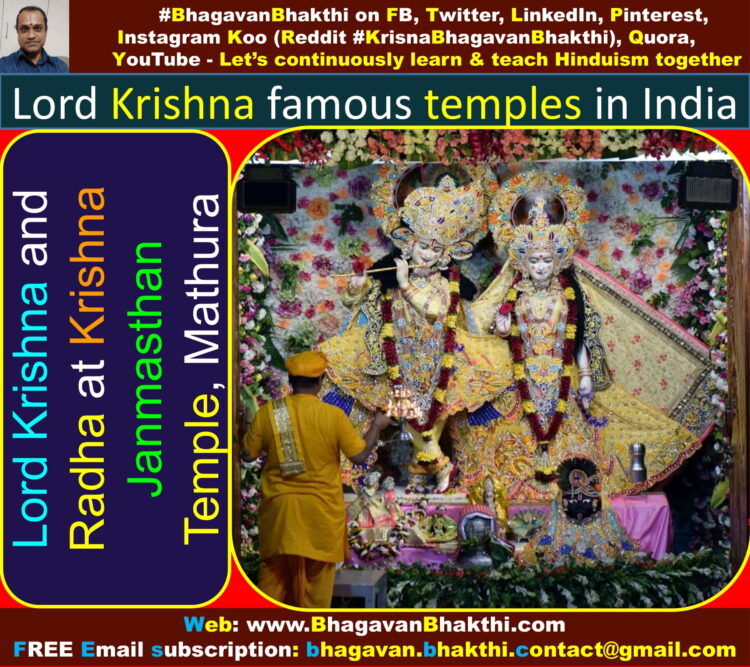
This temple was destroyed multiple times by many Islamic invaders including Aurangzeb.
Dwarkadhish Temple, Dwaraka : Here Dwarkadhish means Lord Krishna.
The Dwarkadhish temple is also called as the Jagat Mandir. Few people pronounce this as Dwarakadheesh temple.
This temple is dedicated to Lord Krishna, who is worshiped as name Dwarkadhish (King of Dwarka).
The temple is located at Dwarka city of present state Gujarat.
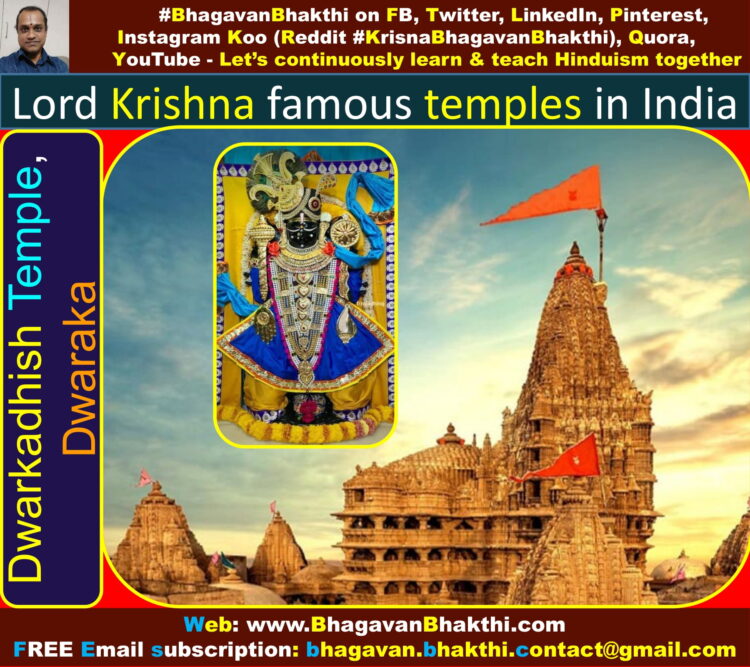
This temple is one of the destinations of Char Dham (4 divine pilgrimage places) of Lord Krishna (Lord Vishynu).
The main deity of the five-storied building, supported by 72 pillars, is known as Jagat Mandir or Nija Mandir.
Archaeological survey has provided proof that, the original temple was built 2,200 years ago.
The Dwarkadhish Temple is a Pushtimarg temple and thus this temple follows the guidelines and rituals instructed by Vallabhacharya and Vitheleshnath.
According to tradition, the original temple was believed to have been built by Lord Krishna’s great grandson, Vajranabha, over the hari-griha (Krishna’s residential place).

The original temple structure was destroyed by the Islamic invader called as Mahmud Begada in 1472.
The other three dhams (Among the char dham / 4 pilgrimage temples) are Rameswaram (south), Badrinath (north) and Puri (east).
Sri Vitthal Rukmini Temple, Pandharpur : This temple is also dedicated to Lord Krishna.
Sri Vitthal Rukmini Temple is in the Maharashtra state.
This divine temple was built by the King Vishnuvardhana of Hoysala empire between 1108–1152 CE upon being convinced by the great devotee of Lord Krishna (Vishnu) Pundalik.

The Varkaris (Warkaris) (devotees of Lord Vitthal) start marching from their respective homes towards the temple of Pandharpur in groups called Dindi (procession) to reach on Aashadhi Ekadashi and Kartika Ekadashi.
A dip in the holy river Chandrabhaga (Bhima river), on whose banks Pandharpur resides, is believed to have power to wash all sins.
All the devotees are allowed to touch the feet of the deity of Lord Vitthal (Vithoba / Panduranga).
Udupi Sri Krishna Matha, Udupi : Udupi Sri Krishna Temple is dedication to Lord Krishna.
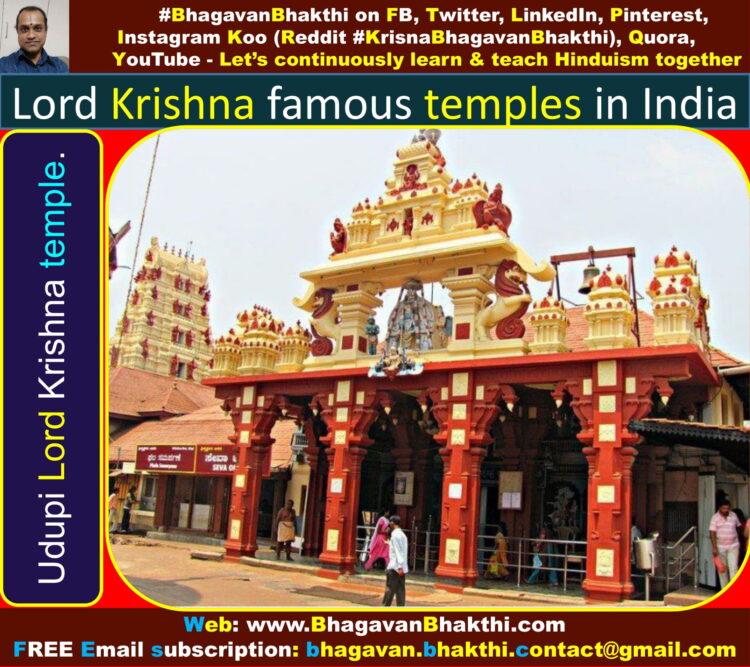
The Matha (Mutt / Math / मठ) area resembles a living ashram, a holy place for daily devotion and living.
Surrounding the Lord Sri Krishna Temple are several temples namely the Udupi Anantheshwara Temple which is over a thousand years old.
The Lord Sri Krishna Matha was founded by great and most divine Vaishnavite saint Jagadguru Sri Madhvacharya Ji in the 13th century.
Sri Madhvacharya Ji is the founder of the Dvaita Siddhanta of Vedanta (All are different and unique).
Sri Madhvacharya Ji found the deity of Lord Sri Krishna in a large ball of gopichandana (Gopi Chandan).

Lord Krishna’s devotees always have darshan of Lord Krishna through the inner window, known as the Navagriha Kindi & the outer window known as the Kanakana Kindi (Kanada Dasa’s window).
Jagannath Temple, Puri : This temple is also dedicated to Lord Krishna (Lord Vishnu)
The Puri Jagannath Temple is highly auspicious temple dedicated to Lord Jagannath, a form of Lord Vishnu.
Puri Jagannath Temple is in the Odisha state on the eastern coast of India.
The present temple was rebuilt in the 10th century onwards by Anantavarman Chodaganga, the first king of the eastern Ganga dynasty.

The Puri Jagannath temple is famous for its annual Ratha Yatra, or chariot festival, in which the three principal deities are pulled on huge and elaborately decorated temple cars.
The three main deities are Lord Jagannath (Lord Krishna), Lord Balabhadra (Lord Balarama) and Subhadra Devi (sister of Lord Krishna and Lord Balarama).
The deity of Lord Sri Jagannath is made of wood and is ceremoniously replaced every twelve or 19 years by an exact replica.
It is one of the Char Dham pilgrimage sites (Others are Badrinath, Dwarkadhish and Rameswaram).
This is the place where Lord Vishnu will be sleeping on the VataPatra (banyan leaf).
Prem Mandir, Vrindavan : Prem Mandir (The Temple of Love) is a temple in Vrindavan (Mathura state of Uttar Pradesh state).
The temple complex is on a 55 acre site on the outskirts of Vrindavan.
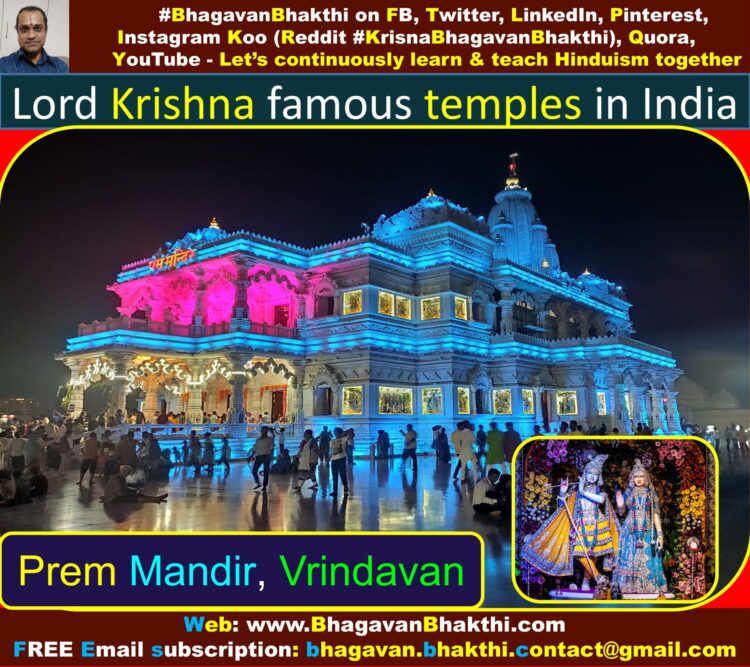
This divine temple is dedicated to ‘Radha Krishna’ and ‘Sita Ram’.
Radha Krishna are on the first level and Sita Ram are on the second level.
Different Leelas of Lord Sri Krishna and Rasik saints are depicted all over the wall of the main temple.
Surrounded by beautiful gardens and fountains, the temple complex has life-size depictions of four leelas of Lord Sri Krishna, that is, Jhulan leela, Govardhan leela, Raas leela and Kaliya Naag leela.
Sri Govindajee Temple, Imphal : Sri Govindajee Temple (Sri Govindji) temple is the largest Vaishnava temple in Imphal district of Manipur state.
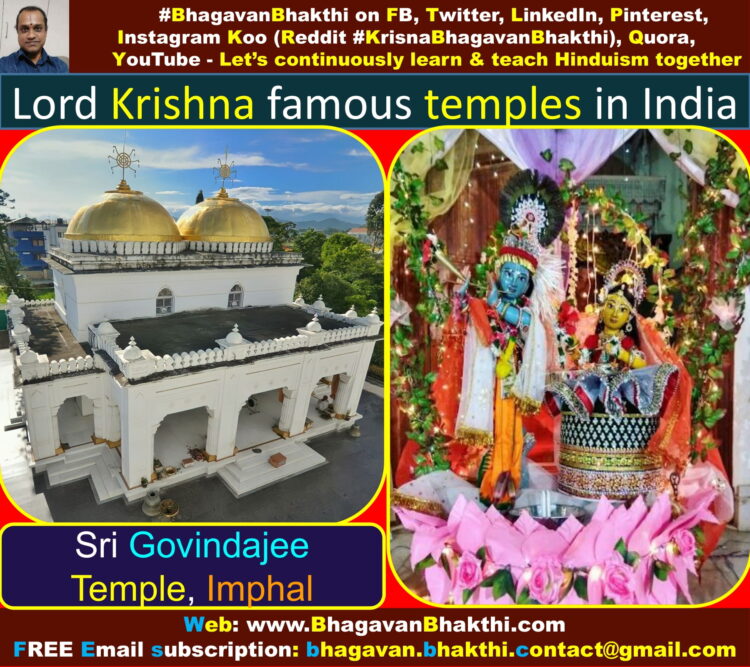
The Sri Govindajee Temple in Imphal is simple in design with two gold plated domes, a paved court and a large, raised mantapa, or congregation hall.
The garbhagriha (sanctum sanctorum) has Lord Sri Govindaji (Lord Krishna) and his consort Sri Radha Devi as the main deities.
The other two sides on the either side of the central altar is dedicated to Lord Krishna and Lord Balarama on one side and Jagannath, Subhadra and Balabhadra on the other side.
The Sri Govindajee temple in Imphal was originally built in 1846 during the reign of Maharaja Nara Singh and again reconstructed by Maharaja Chandrakriti in 1876.
Kantajew Temple, Bangladesh : The temple of Kantajew in Bangladesh is dedicated to Lord Krishna.
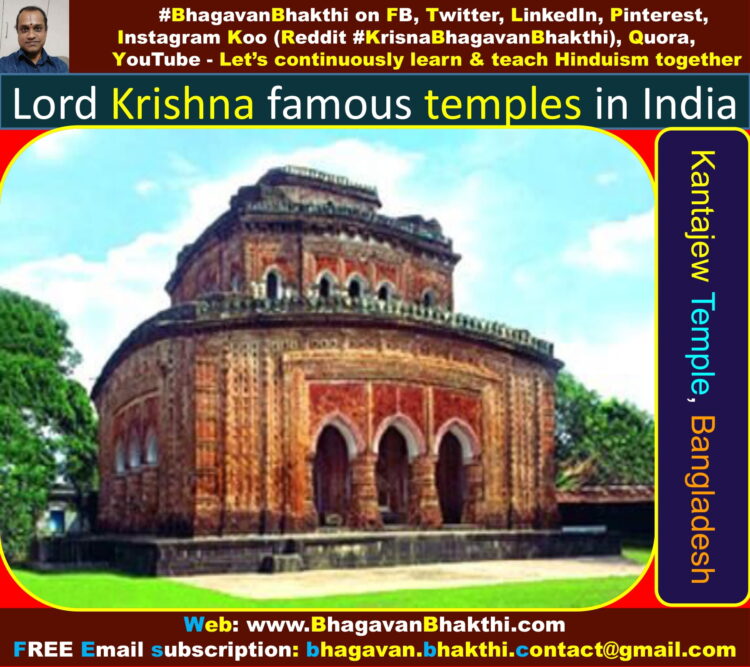
Kantanagar Temple or simply called as Kantaji Temple or Kantajew Temple is a late-medieval temple in Dinajpur, Bangladesh.
The temple belongs to the Kanta or Krishna and this is most popular with the Radha-Krishna combination of memorable love in Bengal.
This temple is dedicated to Lord Krishna and his wife Sri Rukmini Devi.
The Kantajew Temple in Bangladesh was constructed by Maharaja Pran Nath in 1704 CE and ended in the reign of his son Raja Ramnath in 1722 CE.
It is a great example of terracotta architecture in Bangladesh and once had nine spires, but all were destroyed in an earthquake in 1897.
The Kantajew Temple in Bangladesh was built in a ‘navaratna’ that is, nine-spired style before the destruction caused by the earthquake of 1897.
Bankey Bihari Temple, Vrindavan : Bankey Bihari Temple is situated in the town of Vrindavan, Mathura district of Uttar Pradesh state.

The temple is dedicated to Bankey Bihari (Radha Krishna) who is believed to be the combined form of Sri Radha Devi and Lord Sri Krishna.
Bankey Bihari (Radha Krishna) was originally worshipped at Nidhivan, Vrindavan.
But, later when Bankey Bihari temple was constructed around 1864, deity of Bankey Bihari was moved to new temple.
The deity image of Radha Krishna’s unified form stands in the Tribhanga posture.
Swami Haridas first worshipped this devotional deity with the name of Kunj-Bihari.
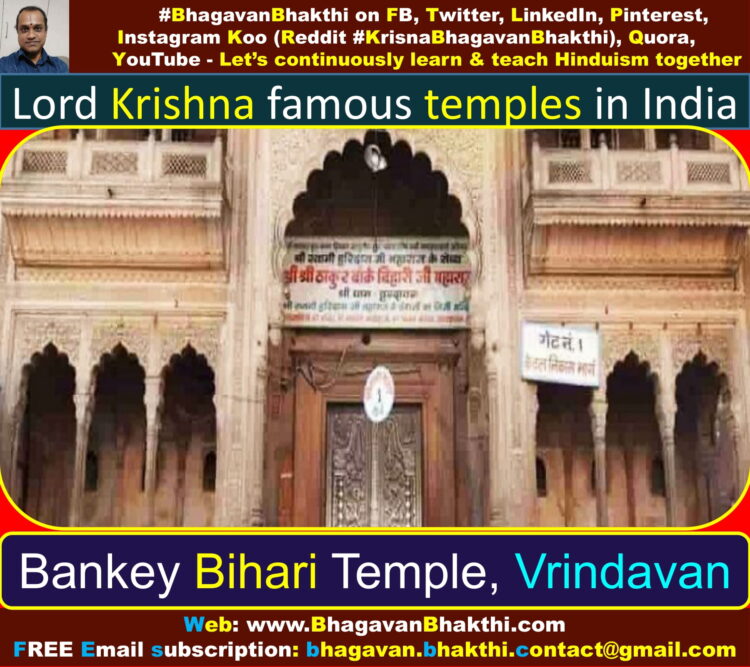
(Here Kunj-Bihari means, someone who enjoys in the groves (Kunj) of Vrindavan).
Here bānke means bent, and bihāri’ (vihāri) means ‘enjoyer’.
This is how Lord Krishna, who is bent in three places, got the name Banke Bihari.
Radha Madhab Temple, Bishnupur : Correct pronunciation of this temple is Radha Madhava (Madhav) Temple.
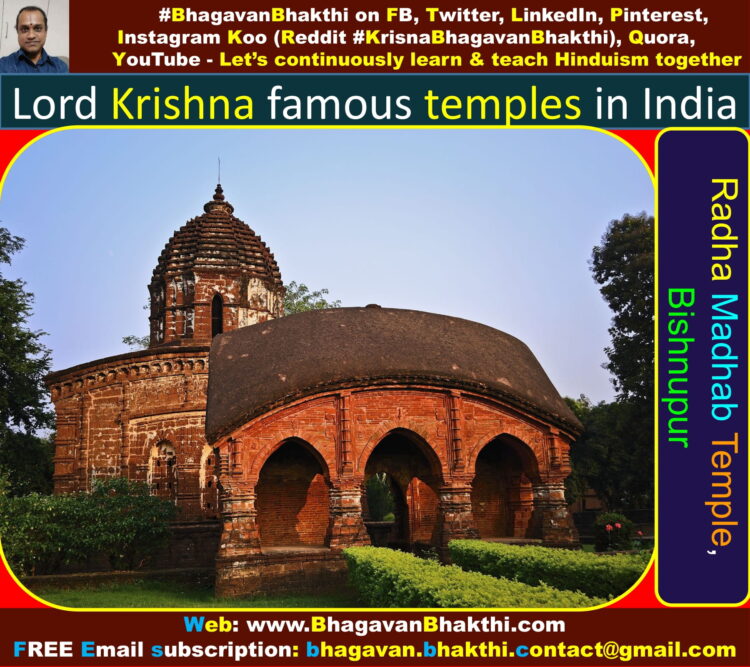
Radha Madhab Temple is located in Bishnupur, West Bengal, India.
The temple was built in 1737 by the ruling Malla dynasty, and is dedicated to Sri Radha Devi and Lord Sri Krishna.
Radha Raman Temple, Vrindavan : Sri Radha Raman Temple, is located in Vrindavan, Mathura state.

Sri Radha Raman temple is dedicated to Lord Krishna who is worshiped as Sri Radha Ramana (Sri Radha Raman).
This temple is counted as one of the Seven most revered ancient temples of Vrindavan.
The other temples are: Sri Radha Vallabh Temple, Sri Radha Damodar Temple, Sri Radha Madanmohan Temple, Sri Radha Govindji Temple, Sri Radha Shyamsundar Temple and Sri Radha Gokulnandan Temple.
Sri Radha Raman temple houses the original Shaligram deity of Lord Krishna alongside Goddess Sri Radha Devi.
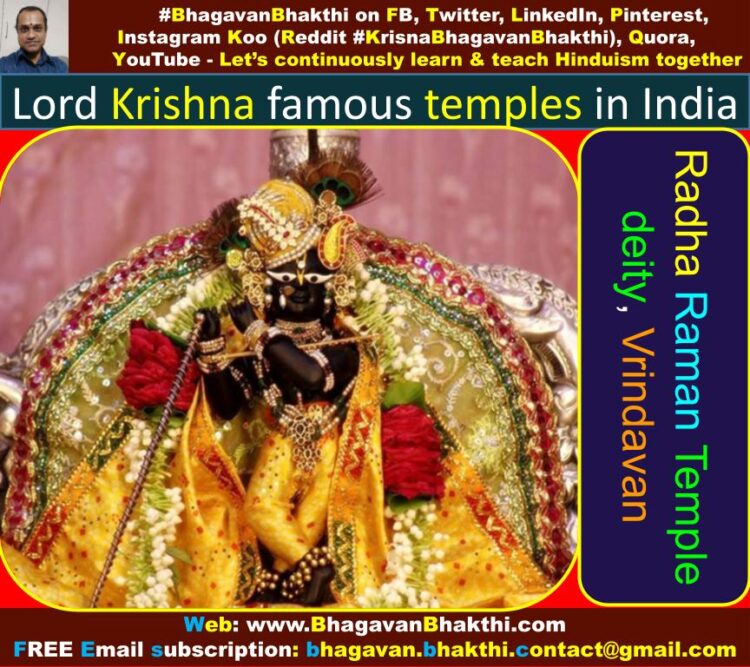
Here Sri Radha Raman = Radha + Ramana = Radha’s + Lover (ramana).
That is, Lord Krishna is the lover of Goddess Sri Radha Devi.
Shrinathji Temple, Nathdwara, Rajasthan : Shrinathji Temple is located in Nathdwara in Rajsamand district of Rajasthan.
The deity of the Shrinathji (Lord Krishna) according to the legend is swayambhu (self-manifested) from stone and emerged from the Govardhan Hills.
As per Hindu shastras, the deity of Shrinathji (Lord Krishna) was first worshipped at Govardhan hill, near Mathura.
The deity was initially shifted from Mathura in 1672 CE alongside the river Yamuna.
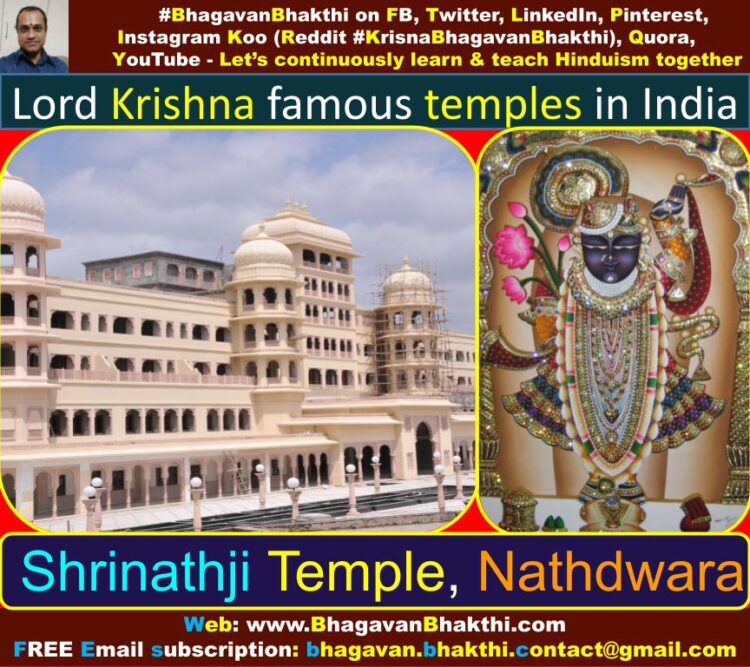
And later this deity was retained at Agra for almost six months, in order to safeguard it from the Mughal ruler Aurangzeb, who wished to keep the divine deity with him in Agra.
Then later, the deity was transferred further south on a chariot to a safer place to protect it from barbaric destruction unleashed by the Islamic Mughal ruler Aurangzeb.
When the deity reached the spot at village Sihad (Sinhad), the wheels of the bullock cart in which the deity was being transported sank axle-deep in mud and could not be moved any farther.
The accompanying priests realized that the particular place was the Lord’s chosen spot and accordingly, a temple was built there under the rule and protection of the then Maharana Raj Singh of Mewar.
Shrinathji Temple is also known as ‘Haveli of Shrinathji’ (Mansion of Lord Krishna).
The temple was built by Goswami Damodar Das Bairagi in 1672.
Madan Mohan Temple, Karauli, Rajasthan : Sri Madan Mohan Temple is located at Karauli, in Rajasthan state.
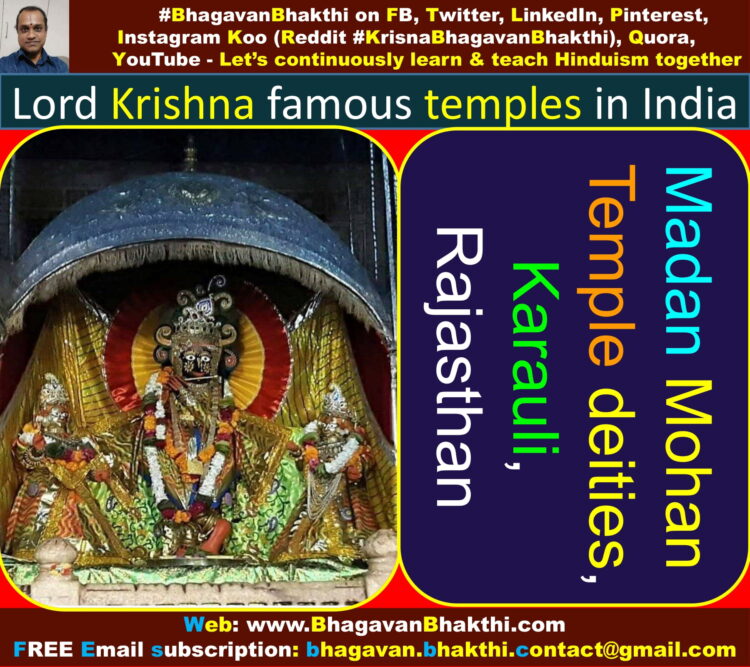
The Sri Madan Mohan temple is situated on the banks of the Bhadravati river, a tributary of the Banas River in the hills of Aravali.
The temple is dedicated to Lord Sri Madan Mohan (Lord Krishna).
In the central altar, Lord Krishna is flanked with the deities of his consort Goddess Sri Radha Devi and Lalita on either side.
At one night, King Gopal Singh was instructed by Lord Krishna in his dream to bring his Sri Madan Mohan deity from Vrindavan to Rajasthan before the attack of Islamic Mughal emperor Aurangzeb on Vrindavan temples.
As per instructions, the king of Karauli brought the original deity of Sri Madan Mohan with him overnight and got this temple constructed at Karauli.

It is also said that to protect deity of Lord Krishna from the Islamic invaders, two deities were brought from Vrindavan and placed one at Karauli and another one at Jaipur.
It is said that to complete the Govardhan Yatra, it is compulsory to visit Sri Madan Mohan temple and Sri Govind Dev Ji Temple.
Sri Madan Mohan is one of the ‘Char Dham’ (4 pilgrimage temples) of Karauli District.
Other three are Kaila Devi Temple, Mehandipur Balaji Temple and Shri Mahavirji.
Guruvayur Temple, Kerala : Here Lord Krishna is known as Sri Guruvayurappan (four-armed form of the Lord Vishnu).

Sri Guruvayur (Guruvayurappan) temple is located at Guruvayur in Kerala state.
It is one of the most important places of worship for Hindus in Kerala and Tamilnadu and is often referred to as Bhuloka Vaikuntha.
That is, the divine abode of Lord Krishna (Vishnu) on earth.
This deity of Lord Guruvayurappan (Lord Krishna) represents the divine form of Lord Vishnu as revealed to Lord Krishna’s parents Vasudeva and Devaki at the time of Lord Sri Krishna’s birth.
According to Hindu shatras, Janamejaya conducted a huge sacrifice to destroy all the snakes on the earth including Takshaka, who was the main cause of his father Parikshit’s death.
Millions of snakes fell into the sacrificial fire and were killed, but the sacrifice was stopped by a Brahmin known as Astika, before Takshaka was killed.
Since Janamejaya was responsible for the death of millions of snakes, he was afflicted with leprosy.
Janamejaya lost all hope of a cure.
But, one day the Sage Atreya (Maharishi Atri’s son) came before Janamejaya and told him to take asylum under the feet of Lord Krishna (Guruvayurappan) at Guruvayur.
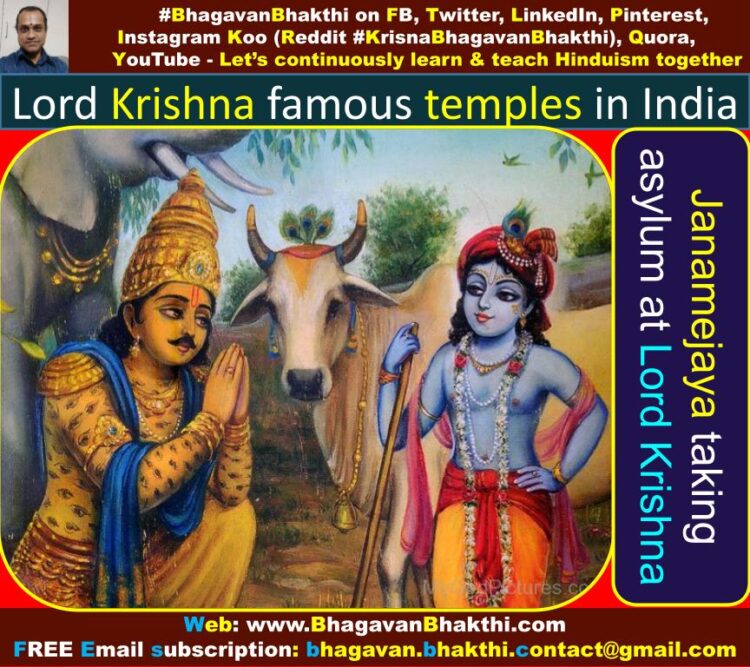
Sage Atreya told him that in the temple at Guruvayur the effulgence of Lord Vishnu is at its best and Lord Vishnu showers his blessings on all devotees.
Janamejaya immediately rushed there and spent the next ten months worshipping the Lord Guruvayurappan (Lord Krishna).
At the end of ten months, Janamejaya returned home healthy and took the astrologer to task for making a incorrect prediction.
The astrologer told him that he would find the mark of a snakebite on his left leg.
Janamejaya had escaped death only because he was at that time in a temple where Lord Aadi Shesha (Ananta, the emperor of serpents) was present.
And Lord Aadi Shesha was the brother to Lord Krishna (as Balarama) at Guruvayur where he had finished worshipping.
Radha Vallabh Temple, Vrindavan : Sri Radha Vallabh Temple is also called as Sri Radha Vallabhlal ji Temple.
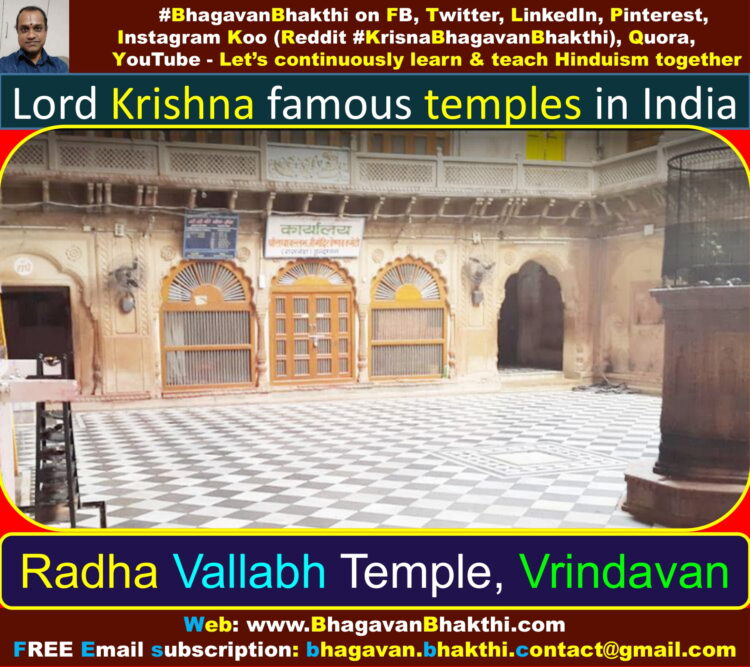
Sri Radha Vallabh temple is a historic and divine temple in the city of Vrindavan, Mathura district, Uttar Pradesh state.
Sri Radha Vallabh temple is dedicated to Goddess Sri Radha Devi and Lord Sri Krishna.
The central deity of the temple is Lord Krishna who is worshiped under the name of Shri Radha Vallabh.
Here Radha Vallabh means the consort and divine lover of Goddess Sri Radha Devi.
Sri Radha Vallabh temple was built in 16th century under the guidance of Vrindavan saint Hith Harivansha Mahaprabhu.
As per the legend, the deity of Sri Radha Vallabh was never made by any sculptor.
The deity was given to a devotee named Atmadev by Lord Shiva himself because of his arduous devotion and prayers.
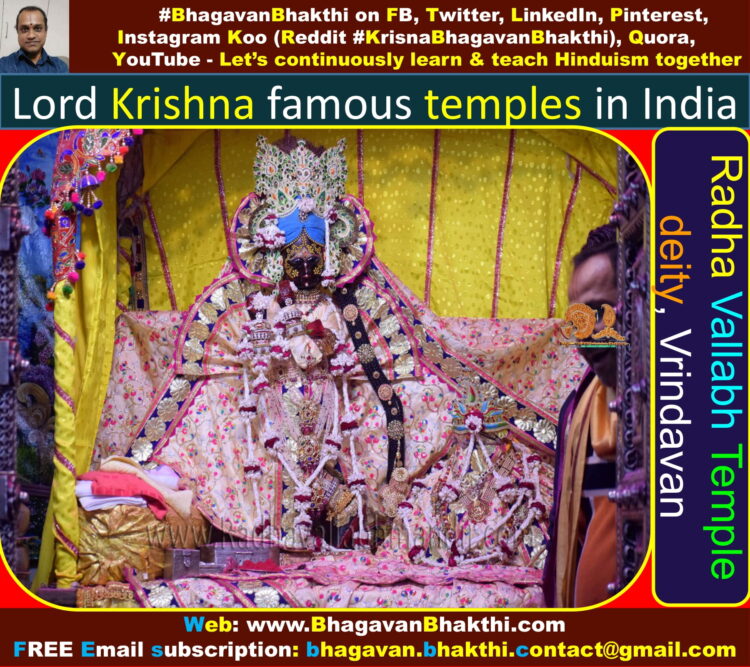
The Hith Harivansh Mahaprabhu lived 31 years in place known as Devavan.
In the 32nd year, Hith Harivansh Mahaprabhu left for Vrindavan.
On his way to Vrindavan, he was ordered by Goddess Sri Radha Devi to marry the daughters of Atmadev and took the deity of Sri Radha Vallabh to Vrindavan with them.
As ordered, Hith Harivansh Mahaprabhu married the daughters of Atmadev and Atmadev gifted the deity of Sri Radha Vallabh to his daughters and Harivansh Mahaprabhu on their marriage.
Radha Madan Mohan Temple, Vrindavan : Sri Radha Madan Mohan Temple is located in Vrindavan, in Mathura in Uttar Pradesh state.
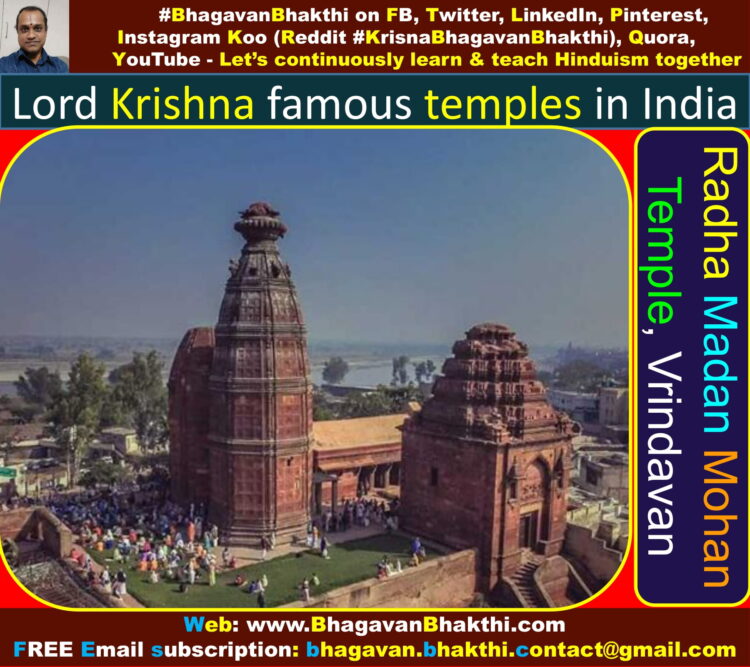
Sri Radha Madan Mohan temple is one of the oldest and highly revered temple of Vrindavan.
The main deity of Sri Radha Madan Mohan temple is Sri Madan Mohan (Lord Krishna).
Sri Madan Mohan is present in the central altar of the temple with his consort Goddess Sri Radha Devi and Lalita Gopi on either sides of him.
Sri Radha Madan Mohan temple is built in the Nagara style of architecture.
On the bank of Yamuna River, Sri Radha Madan Mohan temple stands at a height of 50 feets near Kaliya Ghat.
It is also one of the most popular Goswami shrines in Uttar Pradesh.
According to popular legend, Sri Radha Madan Mohan temple in Vrindavan is 5000 years old.
It was first believed to be constructed by the great grandson of Lord Krishna, that is, by Vajranabh.
Radha Damodar Temple, Junagadh : Sri Radha Damodar Temple is located in the Junagadh district of Gujarat state.
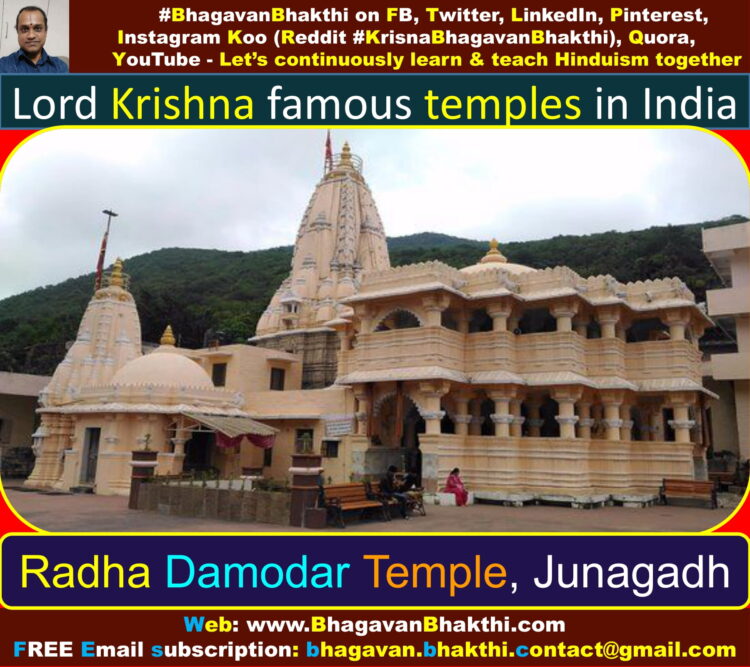
The temple is dedicated to the Lord Damodar Hari, another name of Lord Sri Krishna.
In this temple, Lord Damodar (Lord Krishna) is worshiped in his four arms form of Lord Vishnu along with the Goddess Sri Radha Devi who is seated next to him in the central shrine.
Inside temple premises, Damodar kund and Revati kund are also present.
It is believed that temple was built by Vajranabh, the great grandson of Lord Krishna.
Govind Dev Ji Temple, Jaipur : The temple is dedicated to Lord Govind Dev (Lord Krishna) and his consort Goddess Sri Radha Devi.
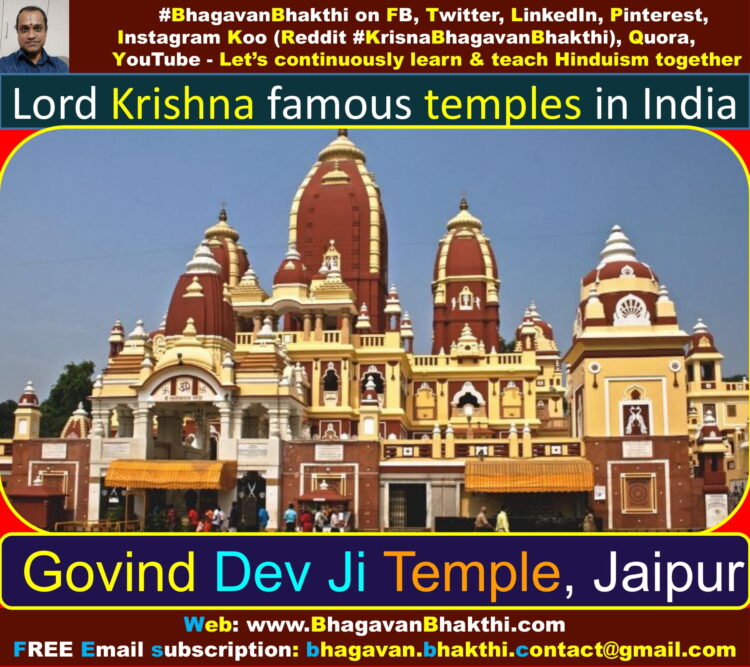
According to the popular legend, the deity of Lord Sri Govind Devji is also called “Bajrakrit”.
This is because it was created by Bajranabh (Vajranabh), that is, the great grand son of Lord Krishna.
Around 5,000 years ago when Bajranabh (Vajranabh) was around 13 years old, he asked his Grand mother (daughter-in-law of Lord Krishna) as to how Lord Krishna looked like.
Then based on her description, he made three deities.
In first deity, the feet show the resemblance with the Lord Krishna’s feet.
In second deity, chest area looked like Lord Krishna.
In third deity, the face showed complete resemblance with Lord Krishna face when he was incarnated on Earth.
The first one deity is known as Lord Madan Mohan ji.
The second deity is called as Lord Gopinath ji, and
The third deity is known as Govind Devji.
More information will be added to this on regular, please visit after some time to know more information.
To watch videos on #Hinduism #Sanskrit language, SUBSCRIBE to my YouTube channel from this below link:
#BhagavanBhakthi YouTube channel
To know about “Ekadashi unknown facts” and real significances of Ekadashi fasting, kindly click the below link:
To know more about “Lord Krishna unknown facts“, please click the below link:
To know more about “Lord Vishnu unknown facts“, please click the below link:
To know more about “Lord Shiva unknown facts“, please click the below link:
Dear friends, if you need any clarifications about this post, kindly let me know, I will definitely try to answer all of them.
Also your one LIKE, one COMMENT, One Share, one SUBSCRIPTION is highly important.
This will help to know the quality of this content and also it will be helpful to know if any improvements is required for the content.
If you feel this content is useful to you and has helped you to improve your knowledge, kindly share this with your well-wishers.
Because “SHARING MEANS CARING”.
For receive FREE EMAIL SUBSCRIPTION about #BhagavanBhakthi, you can send an email to [email protected] from your email ID.
NAMASTE!
Sri Gurubhyo Namaha
OM NAMO NARAYANAYA
Sri Krishnaarpanamastu
Subscribe / Follow us Share in Social Media
Fantastic beat ! I wish to apprentice at the same time as you amend your web site, how could i subscribe for a blog site? The account aided me a appropriate deal. I have been tiny bit familiar of this your broadcast provided vivid clear idea
I really appreciate this post. I’ve been looking everywhere for this! Thank goodness I found it on Bing. You’ve made my day! Thx again!
It¦s actually a great and helpful piece of information. I am happy that you simply shared this useful info with us. Please keep us up to date like this. Thank you for sharing.